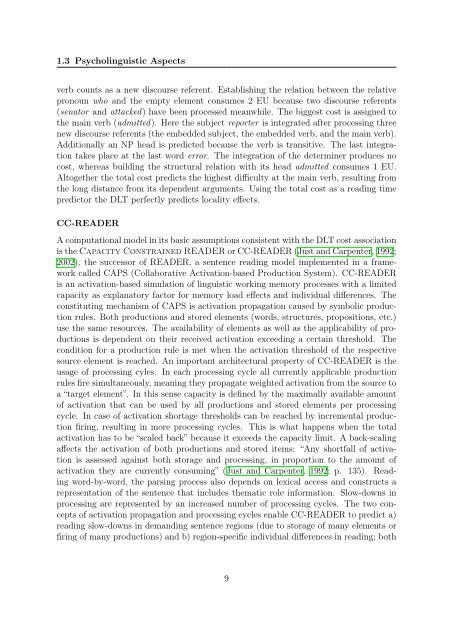Connectionist Modeling of Experience-based Effects in Sentence ...
Connectionist Modeling of Experience-based Effects in Sentence ...
Connectionist Modeling of Experience-based Effects in Sentence ...
Create successful ePaper yourself
Turn your PDF publications into a flip-book with our unique Google optimized e-Paper software.
1.3 Psychol<strong>in</strong>guistic Aspects<br />
verb counts as a new discourse referent. Establish<strong>in</strong>g the relation between the relative<br />
pronoun who and the empty element consumes 2 EU because two discourse referents<br />
(senator and attacked) have been processed meanwhile. The biggest cost is assigned to<br />
the ma<strong>in</strong> verb (admitted). Here the subject reporter is <strong>in</strong>tegrated after process<strong>in</strong>g three<br />
new discourse referents (the embedded subject, the embedded verb, and the ma<strong>in</strong> verb).<br />
Additionally an NP head is predicted because the verb is transitive. The last <strong>in</strong>tegration<br />
takes place at the last word error. The <strong>in</strong>tegration <strong>of</strong> the determ<strong>in</strong>er produces no<br />
cost, whereas build<strong>in</strong>g the structural relation with its head admitted consumes 1 EU.<br />
Altogether the total cost predicts the highest difficulty at the ma<strong>in</strong> verb, result<strong>in</strong>g from<br />
the long distance from its dependent arguments. Us<strong>in</strong>g the total cost as a read<strong>in</strong>g time<br />
predictor the DLT perfectly predicts locality effects.<br />
CC-READER<br />
A computational model <strong>in</strong> its basic assumptions consistent with the DLT cost association<br />
is the Capacity Constra<strong>in</strong>ed READER or CC-READER (Just and Carpenter, 1992;<br />
2002), the successor <strong>of</strong> READER, a sentence read<strong>in</strong>g model implemented <strong>in</strong> a framework<br />
called CAPS (Collaborative Activation-<strong>based</strong> Production System). CC-READER<br />
is an activation-<strong>based</strong> simulation <strong>of</strong> l<strong>in</strong>guistic work<strong>in</strong>g memory processes with a limited<br />
capacity as explanatory factor for memory load effects and <strong>in</strong>dividual differences. The<br />
constitut<strong>in</strong>g mechanism <strong>of</strong> CAPS is activation propagation caused by symbolic production<br />
rules. Both productions and stored elements (words, structures, propositions, etc.)<br />
use the same resources. The availability <strong>of</strong> elements as well as the applicability <strong>of</strong> productions<br />
is dependent on their received activation exceed<strong>in</strong>g a certa<strong>in</strong> threshold. The<br />
condition for a production rule is met when the activation threshold <strong>of</strong> the respective<br />
source element is reached. An important architectural property <strong>of</strong> CC-READER is the<br />
usage <strong>of</strong> process<strong>in</strong>g cyles. In each process<strong>in</strong>g cycle all currently applicable production<br />
rules fire simultaneously, mean<strong>in</strong>g they propagate weighted activation from the source to<br />
a “target element”. In this sense capacity is def<strong>in</strong>ed by the maximally available amount<br />
<strong>of</strong> activation that can be used by all productions and stored elements per process<strong>in</strong>g<br />
cycle. In case <strong>of</strong> activation shortage thresholds can be reached by <strong>in</strong>cremental production<br />
fir<strong>in</strong>g, result<strong>in</strong>g <strong>in</strong> more process<strong>in</strong>g cycles. This is what happens when the total<br />
activation has to be “scaled back” because it exceeds the capacity limit. A back-scal<strong>in</strong>g<br />
affects the activation <strong>of</strong> both productions and stored items: “Any shortfall <strong>of</strong> activation<br />
is assessed aga<strong>in</strong>st both storage and process<strong>in</strong>g, <strong>in</strong> proportion to the amount <strong>of</strong><br />
activation they are currently consum<strong>in</strong>g” (Just and Carpenter, 1992; p. 135). Read<strong>in</strong>g<br />
word-by-word, the pars<strong>in</strong>g process also depends on lexical access and constructs a<br />
representation <strong>of</strong> the sentence that <strong>in</strong>cludes thematic role <strong>in</strong>formation. Slow-downs <strong>in</strong><br />
process<strong>in</strong>g are represented by an <strong>in</strong>creased number <strong>of</strong> process<strong>in</strong>g cycles. The two concepts<br />
<strong>of</strong> activation propagation and process<strong>in</strong>g cycles enable CC-READER to predict a)<br />
read<strong>in</strong>g slow-downs <strong>in</strong> demand<strong>in</strong>g sentence regions (due to storage <strong>of</strong> many elements or<br />
fir<strong>in</strong>g <strong>of</strong> many productions) and b) region-specific <strong>in</strong>dividual differences <strong>in</strong> read<strong>in</strong>g; both<br />
9
















